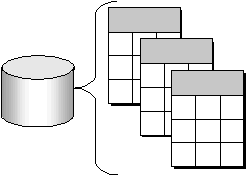







ASA Getting Started
Databases and Applications
Relational database concepts
In a relational database, all data is held in tables, which are made up of rows and columns.

Each table has one or more columns, and each column is assigned a specific data type, such as an integer, a sequence of characters (for text), or a date. Each row in the table has a single value for each column.
For example, a table containing employee information may look as follows:
| emp_ID | emp_lname | emp_fname | emp_phone |
|---|---|---|---|
| 10057 | Huong | Zhang | 1096 |
| 10693 | Donaldson | Anne | 7821 |
The tables of a relational database have some important characteristics:
There is no significance to the order of the columns or rows.
Each row contains one and only one value for each column, or contains NULL, which indicates that there is no value for that column.
All values for a given column have the same data type.
The following table lists some of the formal and informal relational database terms describing tables and their contents, together with their equivalent in non-relational databases. This manual uses the informal terms.
| Informal relational term | Formal relational term | Non-relational term |
|---|---|---|
| Table | Relation | File |
| Column | Attribute | Field |
| Row | Tuple | Record |
Each table in the database should hold information about a specific thing, such as employees, products, or customers.
By designing a database this way, you can set up a structure that eliminates redundancy and the possible inconsistencies caused by redundancy. For example, both the sales and accounts payable departments might enter and look up information about customers. In a relational database, the information about customers is stored only once, in a table that both departments can access.
For more information about database design, see Designing Your Database.
For instructions on how to create a table, see Lesson 3: Design and create a table.



